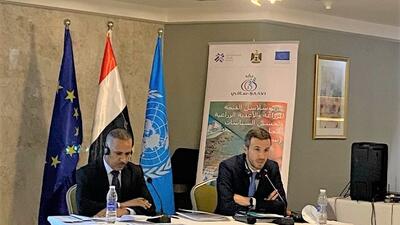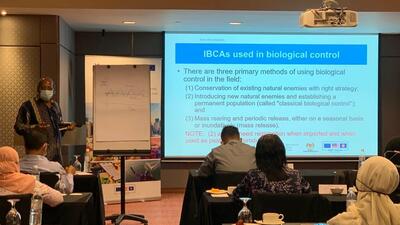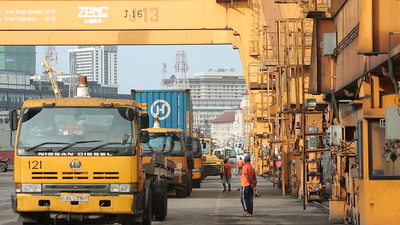Benefitting from better Aid-for-Trade flows
A good harvest, but more trade liberalization would help.© ADB
At a time when Aid-for-Trade flows have declined in every major region, Asia has emerged as the recipient of the largest share of flows. Still, this measurement from Aid for Trade at a Glance 2013, a joint publication by the Organisation for Economic Co-operation and Development (OECD) and the World Trade Organization (WTO), disguises the dichotomy that exists between most of Asia’s developing countries and its challenged economies, including least developed countries (LDCs), landlocked least developed countries (LLDCs) and small island developing States (SIDS). Reasonably positive Aid-for-Trade trends in the Asian region are disproportionately captured by the more advanced developing countries, while many of Asia’s most challenged economies continue to struggle to capture gains from trade.
Aid for Trade remains an important feature of the development landscape in Asia. As aid flows from developed economies continue to be constrained as a result of the global financial crisis, countries in Asia have adopted a broader concept of Aid for Trade with an enhanced role for the private sector.
Despite a recent 5% decline in year-on-year flows, Asia’s inflows have risen by 29% over the 2002-2005 baseline. The ability to maintain only a small decrease in inflows in 2011 meant that disruptions to planned projects were relatively limited. WTO has noted that global flows to LDCs were less negatively affected by the crisis and now receive the greatest share of Aid for Trade. This resilience is also true in Asia, where LDCs received 22% of total disbursements in 2011.
A second trend in Aid for Trade in the region is the rise of South-South cooperation measures, with some evidence pointing to rapid growth in recent years. This is largely driven by China and India, but a number of other new players have emerged, including Malaysia and Indonesia. These new players favour a wider range of trade-promotion tools that often target the private sector, such as concessional export credits and training programmes.
A third feature of Asia’s recent Aid-for-Trade experience has been the rise of public-private dialogues that enable governments to more effectively prioritize reforms and better target Aid-for-Trade resources. The Asian Development Bank’s recently published regional review, Aid for Trade in Asia and the Pacific: Driving Private Sector Participation in Global Value Chains, highlights some successful examples. These cooperative efforts enable Aid for Trade to be directed to the specific impediments that are identified by the private sector.
Asia’s trade environment is relatively more integrated than other regions, in terms of the number of formal trade arrangements and also as measured by regional value-chain trade. Trade is a driver of growth for the region, and Aid for Trade has supported needed facilities and reforms. Yet while regional integration presents excellent opportunities for Asia’s challenged economies, the reality is that few have successfully captured these potential gains.
One problem has been the proliferation of free trade agreements (FTAs) in the region. While the number of arrangements has increased rapidly, with 109 ratified FTAs involving an Asian country as of January 2013, Asia’s challenged states have for the most part only taken part as members of a regional partner (for example, in the Association of Southeast Asian Nations (ASEAN)+1 FTAs). While they have a seat at the table, there is little evidence to suggest that these FTAs reflect the needs and realities of countries with limited trade and bureaucratic capacity. More importantly, there is concern that these initiatives are diverting limited resources away from more pressing tasks, such as simplifying cross-border procedures.
Another bottleneck comes from supply-chain trade that often bypasses Asia’s challenged states. While there have been some important successes – such as Cambodia – Asia’s LDCs, LLDCs and SIDS remain dependent on a set of exports that is not plugged into this dynamic trade framework.
A final challenge comes from the increasing global focus on foreign direct investment (FDI) as a tool to build trade capacity. FDI flows have increased more quickly than official development assistance in many of Asia’s developing economies in recent years. For countries with the ability to create an enabling business climate that encourages backward and forward linkages, this trend can improve productivity and increase trade capacity. Whether Asia’s challenged states will be able to create such an environment remains to be seen.
The challenges faced by Asia’s LDCs, LLDCs and SIDS in maximizing the benefits from Aid for Trade in the current trade environment suggest the need for a number of policy recommendations. In relation to FTAs, LLDCs such as Lao People’s Democratic Republic and LDCs such as Cambodia should consider opening up their trade preferences to do away with the need to satisfy multiple overlapping rules of origin, for which they have limited capacity. This will also maximize the benefits from trade liberalization. Concerns over loss in government revenue from trade taxes will be offset by the increase in trade volumes that such trade liberalization will generate, and can be further improved by a switch to broad-based indirect taxes as part of an overall tax reform package. It would also reduce the rent-seeking behaviour that deters cross-border trade.
This opening up of trade to participation by several countries should be accompanied by behind-the-border measures that address trade costs, such as service link costs and red tape, which continue to limit the participation of firms from challenged states in regional production networks. These policy reforms usually require national actions taken on a unilateral basis if these countries are to overcome the pressure exerted by incumbents who are keen to protect domestic market share by limiting entry. Such reforms could further boost foreign direct investment flows in an environment where future Aid-for-Trade flows remain uncertain. When such reforms complement public-private partnerships that build much needed physical infrastructure, then the benefits of future Aid-for-Trade flows are likely to be realized with greater benefits to challenged economies.
















